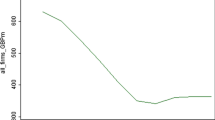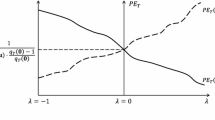Abstract
While the discussion of changes in financial accounting properties over time is already well-established, there is a lack of evidence whether changing firm compositions in empirical samples might bias cost stickiness research. We document that with each additional listing cohort, the U.S. public firm universe becomes more knowledge-intensive and, at the same time, more cost sticky. Higher reliance on temporary labor by newer listing cohorts partly mitigates this development. Our results call for the use of listing cohort-specific slopes to allow for cohort-specific estimates of cost stickiness in future research.
Similar content being viewed by others
Notes
We attribute the higher value for cost increases to our longer sample period which ends in 2014, as compared to 1998 for Anderson et al. (2003)‘s original contribution.
Refer to Table 7 for additional results.
We refer to the intangible asset definition by Lev et al. (2009) which builds on four concepts (p. 276): (1) Discovery/learning intangibles, largely attributable to R&D; (2) Customer-related intangibles, related to brands, trademarks, distribution channels and advertising expenses; (3) Human-resource intangibles, associated with specialist employees, training, and compensation systems; and (4) Organization capital, which refers to unique business processes and corporate cultures allowing the firm to create abnormal profits.
The Fama–French industry 48 is a compound item for firms which are not included in one of the other 47 categories. More specifically, these include firms providing sanitary services, steam and air conditioning supplies, irrigation systems and cogeneration power producers.
We test this by considering the descriptive results presented in Table 1 for each industry, separately. As an example, we exhibit the results for the manufacturing industry in “Appendix B”.
Industry- and year-fixed effects control for unobserved factors. Robust standard errors, clustered at the firm-level, control for autocorrelation and heteroscedasticity.
All variables are defined in detail in “Appendix A”.
SGA cost include all costs related to the running the operations, with the exception of production (e.g., spending on advertising, training, business travel and sales commissions).
Even for the seasoned and 1970s cohorts the effect should be minimal since at most, for a firm already listed in 1970, five firm-year observations are pre-SFAS 2. The only exception to the immediate expensing of R&D outlays are selective development costs for in-house software, following SOP98-1 (AICPA 1998). This should—if at all—work against finding an increase in R&D intensity.
Employing OC, COGS and core expenses as our cost category does not alter the presented conclusions. Only for noncore expenses the results are generally insignificant and not in line with the expectations. We presume that this is in line with the multivariate results presented above (Table 5). Noncore expenses include many components unrelated to increasing intangible capital (e.g., audit and legal fees, restructuring expenses etc.).
In line with extant literature in financial accounting (e.g., Roychowdhury 2006), we set R&D expenses to zero if the value is missing. This presumes that firms which, in fact, undertake material R&D activities also disclose related expenditures in their financial reports. This procedure results in a median of zero R&D expenses and unequal subsamples.
Alternatively, we also employ Tobin’s Q/the market-to-book (MTB) ratio as a proxy for knowledge intensity in our mediation analysis. While the coefficient for cost stickiness is slightly more negative for the above median MTB-subsample, the difference between the coefficients for both subsamples is highly insignificant (t = 0.14). Nonetheless, the MTB ratio proxies for much more than just knowledge intensity, such as, but not limited to, growth prospects, accounting conservatism and underinvestment (e.g., Dybvig and Warachka 2015).
References
AICPA. (1998). Statement of position 98-1—Accounting for the costs of computer software developed or obtained for internal use. http://www.fasb.org/jsp/FASB/Document_C/DocumentPage?cid=1176156442651. Last checked February 17, 2018.
Anderson, M. C., Banker, R. D., & Janakiraman, S. N. (2003). Are selling, general, and administrate costs “sticky”? Journal of Accounting Research, 41(1), 47–63.
Banker, R. D., Basu, S., Byzalov, D., & Chen, J. (2016). The confounding effect of cost stickiness on conservatism estimates. Journal of Accounting and Economics, 61(1), 203–220.
Banker, R. D., & Byzalov, D. (2014). Asymmetric cost behavior. Journal of Management Accounting Research, 26(2), 43–79.
Banker, R. D., Byzalov, D., & Chen, L. T. (2013). Employment protection legislation, adjustment costs and cross-country differences in cost behavior. Journal of Accounting and Economics, 55(1), 111–127.
Banker, R. D., Byzalov, D., Ciftci, M., & Mashruwala, R. (2014). The moderating effect of prior sales changes on asymmetric cost behavior. Journal of Management Accounting Research, 26(2), 221–242.
Banker R. D., Byzalov, D., Fang, S., & Liang, Y. (2017). Cost behavior research. Journal of Management Accounting Research. http://aaajournals.org/doi/abs/10.2308/jmar-51965?code=aaan-site
Bates, T. W., Kahle, K. M., & Stulz, R. M. (2009). Why do U.S. firms hold so much more cash than they used to? The Journal of Finance, 64(5), 1985–2021.
Brüggen, A., & Zehnder, J. O. (2014). SG&A cost stickiness and equity-based executive compensation: Does empire-building matter? Journal of Management Control, 25(3–4), 169–192.
Chen, C. X., Lu, H., & Sougiannis, T. (2012). The agency problem, corporate governance, and the asymmetrical behavior of selling, general, and administrative costs. Contemporary Accounting Research, 29(1), 252–282.
Dierynck, B., Landsman, W. R., & Renders, A. (2012). Do managerial incentives drive cost behavior? Evidence about the role of the zero earnings benchmark for labor cost behavior in private Belgian firms. The Accounting Review, 87(4), 1219–1246.
Dybvig, P. H., & Warachka, M. (2015). Tobin’s q does not measure firm performance: Theory, empirics, and alternatives. Working paper Washington University in Saint Louis and Claremont McKenna College.
Fama, E. F., & French, K. R. (2004). New lists: Fundamentals and survival rates. Journal of Financial Economics, 73(2), 229–269.
Givoly, D., & Hayn, C. (2000). The changing time-series properties of earnings, cash flows and accruals: Has financial reporting become more conservative? Journal of Accounting and Economics, 29(3), 287–320.
Günther, T. W., Riehl, A., & Rößler, R. (2014). Cost stickiness: State of the art of research and implications. Journal of Management Control, 24(4), 301–318.
Hail, L. (2013). Financial reporting and firm valuation: Relevance lost or relevance regained? Accounting and Business Research, 43(4), 329–358.
Hartlieb, S., & Loy, T. R. (2017). Evidence on the trade-off between cost stickiness and income smoothing. Working paper University of Bamberg and University of Bayreuth.
Kama, I., & Weiss, D. (2013). Do earnings targets and managerial incentives affect sticky costs? Journal of Accounting Research, 51(1), 201–224.
Lev, B., Radhakrishnan, S., & Zhang, W. (2009). Organization capital. ABACUS, 45(3), 275–298.
Murphy, K. J. (2013). Executive compensation: Where we are, and how we got there. In G. M. Constantinides, M. Harris, & R. M. Stulz (Eds.). Handbook of the economics of finance (Vol. 2, No. Part B, pp. 211–356). https://www.sciencedirect.com/science/article/pii/B9780444535948000045
Roychowdhury, S. (2006). Earnings management through real activities manipulation. Journal of Accounting and Economics, 42(3), 335–370.
Segal, L. M., & Sullivan, D. G. (1997). The growth of temporary services work. The Journal of Economic Perspectives, 11(2), 117–136.
Srivastava, A. (2014). Why have measures of earnings quality changed over time? Journal of Accounting and Economics, 57(2–3), 196–217.
Srivastava, A., & Tse, S. Y. (2016). Why are successive cohorts of listed firms persistently riskier? European Financial Management, 22(5), 957–1000.
Subramaniam, C., & Weidenmier Watson, M. (2016). Additional evidence on the sticky behavior of costs. Advances in Management Accounting, 26, 275–305.
U.S. Department of Commerce. (2015). Temporary help workers in the U.S. labor market. http://www.esa.doc.gov/sites/default/files/temporary-help-workers-in-the-us-labor-market.pdf. Last checked February 17, 2018.
Venieris, G., Naoum, V. C., & Vlismas, O. (2015). Organisation capital and sticky behaviour of selling, general and administrative expenses. Management Accounting Research, 26, 54–82.
Acknowledgements
Part of this research was conducted while Loy was visiting the University of Nebraska-Lincoln. We thank Marcus Bravidor, Benedikt Downar, Brigitte Eierle, Thomas W. Günther (the editor), Sally Widener, and two anonymous referees for their insights and suggestions. All remaining errors are our own.
Author information
Authors and Affiliations
Corresponding author
Appendices
Appendix A
Appendix B
Rights and permissions
About this article
Cite this article
Loy, T.R., Hartlieb, S. Have estimates of cost stickiness changed across listing cohorts?. J Manag Control 29, 161–181 (2018). https://doi.org/10.1007/s00187-018-0263-3
Published:
Issue Date:
DOI: https://doi.org/10.1007/s00187-018-0263-3




